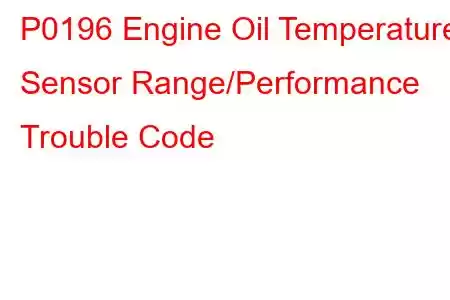P0196 Engine Oil Temperature Sensor Range Performance
OBD-II Trouble Code Technical Description
Engine Oil Temperature Sensor Range/Performance
What does that mean?
This diagnostic trouble code (DTC) is a generic powertrain code, which means that it applies to OBD-II equipped vehicles that have an engine oil temperature sensor (Ford Powerstroke, Chevrolet GMC Duramax, VW, Nissan, Dodge, Jeep, Audi, etc.). Although generic, the exact repair steps may vary depending on make/model.
The engine oil temperature (EOT) sensor produces a signal that is used by the powertrain control module (PCM) to calculate fuel quality, injection timing and glow plug operation. The EOT signal is also compared to other temperature sensors such as the intake air temperature (IAT) sensor and engine coolant temperature (ECT) sensor for diagnostic purposes. EOT sensors are often found in diesel applications.
EOT sensors receive a reference voltage (usually 5 volts) from the PCM. They then vary their internal resistance in relation to engine oil temperature to send a return voltage signal to the PCM. EOT sensors are a type of negative temperature coefficient (NTC) thermistor. This means internal resistance of the sensor is inversely proportional to the oil temperature. The EOT sensor signal voltage goes down when the engine oil temperature goes up and vice versa.
Code P0196 is set when the PCM detects a performance problem with the engine oil temperature sensor sensor.
Related engine oil temperature sensor trouble codes include:
P0195 Engine Oil Temperature Sensor Malfunction P0197 Engine Oil Temperature Sensor Low P0198 Engine Oil Temperature Sensor High P0199 Engine Oil Temperature Sensor IntermittentCode Severity & Symptoms
The severity of these codes is moderate to severe. In some cases, these codes set along with coolant temperature codes, can indicate an engine overheat condition. It’s a good idea to address this code as soon as possible.
Symptoms of a P0196 engine code may include:
Illuminated Check Engine LightA typical engine oil temperature sensor:
Causes
Possible causes for this P0196 code include:
Wiring problems Faulty engine oil temperature sensor Engine cooling system problems Faulty PCMDiagnostic and Repair Procedures
Begin by visually inspecting the engine oil temperature sensor and the corresponding wiring. Look for loose connections, damaged wiring, etc. If damage is found, repair as necessary, clear the code and see if it returns.
Next, check for technical service bulletins (TSBs) regarding the issue. If nothing is found, you will need to move forward to step by step diagnosis of the system.
The following is a generalized procedure, as testing for this code varies between vehicles. To accurately test the system, you'll want to refer to the manufacture’s diagnostic flow chart.
Check for proper cooling system operation
Check that the engine reaches and maintains a proper operating temperature. If the engine overheats or does not warm up as designed, there is a problem with the cooling system that should be addressed prior to any further testing. Cooling system DTCs being set along with an engine oil temperature sensor DTC, also indicate a potential problem with the cooling system.
Do some preliminary circuit testing
Use a scan tool to monitor the engine oil temperature sensor data parameter. Disconnect the EOT sensor; the scan tool value should drop to a very low value. Next, connect a jumper wire across the terminals. If the scan tool now displays a very high temperature, the connections are sound and the ECM can recognize the input. This means the problem is most like the sensor and not a circuit or PCM problem.
Test the sensor
Disconnect the engine oil temperature sensor connector. Next, measure the resista
Read: 47


